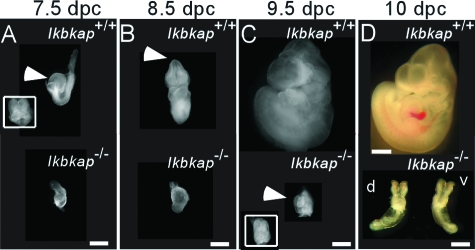FIG. 4.
Appearance of Ikbkap+/+ and Ikbkap−/− embryos at different embryonic stages. Shown are morphological phenotypes of the Ikbkap+/+ and Ikbkap−/− embryos from 7.5 to 10 dpc. At 7.5 dpc, the Ikbkap+/+ embryo undergoes gastrulation and formation of primitive organized structures, such as allantois and head folds (A, inset); however, the Ikbkap−/− embryos appeared to be arrested at the late primitive streak stage, and this feature persisted to 8.5 dpc in the Ikbkap−/− embryo (B). At 8.5 and 9.5 dpc, closure of the anterior neural tube (arrowheads in panels B and C) and body rotation could be observed in wild-type embryos (B and C); in contrast, the Ikbkap−/− embryos lacked these developmental features (B and C). At 9.5 and 10 dpc, the characteristics of the midgastrulation stage, such as allantois, primitive heart, and head fold (C, inset, and D), could be found in the Ikbkap−/− embryo; however, no blood vessels were observed compared with the Ikbkap+/+ control (D). Scale bars, 0.5 mm; in panel D, the scale bar adjacent to the Ikbkap+/+ embryo is 1 mm.

